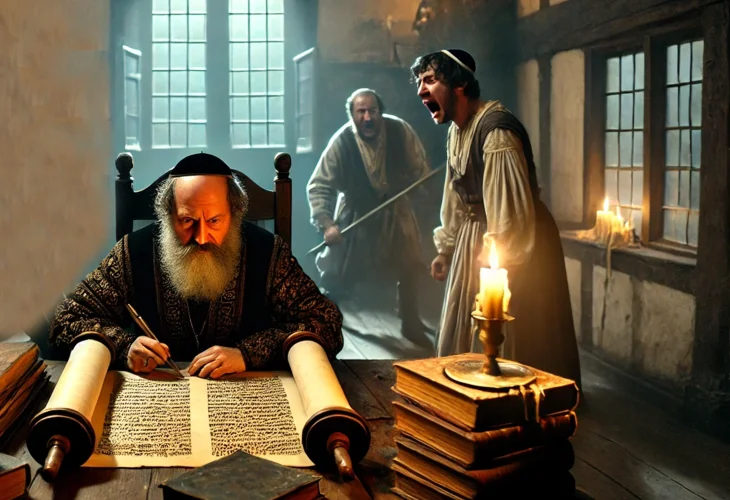Torah Personalities
The Tragic Genius of Rabbi Elazar of Worms: Scholar, Kabbalist, and Survivor
After witnessing the brutal murder of his family, Rabbi Elazar of Worms channeled his pain into writing some of the most influential works of medieval Jewish law and Kabbalah

A Night of Horror and Unimaginable Loss
Nearly 830 years ago, on the night of November 14, 1196 (22 Kislev 4957), Rabbi Elazar of Mainz sat in his home studying the weekly Torah portion, Parshat Vayeishev. He had just read Rashi’s famous comment, “Yaakov wished to dwell in peace…”, when two large, drunken thugs broke into his home. Rabbi Elazar recognized them immediately. They owed him money and had evidently decided to eliminate both their debt and the creditor.
Before he could react, one of them struck him on the head with an axe, knocking him unconscious. From the corner of his eye, he saw the attackers murdering his two daughters. His wife fled to the street in terror, but they caught up with her quickly and killed her as well. Their son, asleep in a nearby room, miraculously survived.
Rabbi Elazar later described the horrific scene:
"They split the head of my older daughter Bilt and of my daughter Chana, and they died… My pious wife immediately got up and ran… crying out that we had been killed. The abominable ones followed and struck her on the head… and the righteous woman fell dead. I shut the door and we cried out until help arrived from Above."
The murderers were brought to trial, and the main perpetrator was executed by hanging. But for Rabbi Elazar, it was far too late. In his lament, he wrote:
Woe is me for my wife, woe is me for my daughters,
I will mourn with a lament, for my sins have overtaken me.
The Judge who judged me is faithful,
In my sins and crimes He humbled me.
To You I will bless in every measure, a song I will sing,
To You I will kneel and bow down.
His righteous wife had been the granddaughter of the Rivan (Rashi’s son-in-law), making her a direct descendant of Rashi himself.
From Tragedy to Torah: The Birth of the “Rokeach”
After recovering from his wounds, Rabbi Elazar left Mainz and moved to Worms, where he was appointed rabbi and head of the rabbinical court. At the time, the city was known as Germayza, earning him the name Rabbi Elazar of Germayza. But he is better known by the title "the Rokeach" ("the Perfumer"), not for mixing physical medicines, but for his spiritual remedies.
His most famous work, Sefer HaRokeach, blends halachic (Jewish legal) rulings with mystical insights and practical Kabbalah. Many later authorities quote his interpretations of mitzvot (Divine commandments) and his spiritual guidance. Writing Torah books was not yet common in his time, but the traumatic events he experienced compelled him to find a way to preserve and disseminate Torah even when face-to-face teaching was not possible.
Despite his towering stature in halachah (Jewish law) and his role in establishing the communal ordinances of the communities of Speyer, Worms, and Mainz, Rabbi Elazar became even more renowned as a Kabbalist. The Bnei Yissaschar famously claimed that all his teachings were received from Eliyahu the Prophet.
Legacy of Halachah, Kabbalah, and Mystical Practice
In the Sefer HaRokeach, Rabbi Elazar outlines rigorous spiritual preparations for learning practical Kabbalah, including immersion, white garments, fasting, and a special blessing: "Before the teacher teaches the student, they should immerse in forty se'ah of water, wear white garments, fast on the day of instruction… then go to a stream, synagogue, or study hall, and the teacher should say: Blessed are You, Hashem… who has sanctified us with His commandments… and given us understanding to know His great and awesome name… Blessed are You, Hashem, who reveals His secrets to Israel."
Many of his halachic rulings became accepted throughout the Jewish world. These include: taking three steps back before the Shemoneh Esrei prayer, omitting Tachanun during the month of Nisan, and reciting the verse “He wraps Himself in light like a garment…” when putting on a tallit. He is also the earliest known source for the Ashkenazi prohibition against eating kitniyot on Passover.
Rabbi Elazar of Worms is also credited with the authorship of the mystical text Raziel HaMalach. The name Raziel is a play on words, an acronym for “Razei Elazar” (Secrets of Elazar), and its contents are drawn from his own work, Galei Razia. These writings, believed to have been revealed by angels and ancient souls, are considered to possess special spiritual power.
He wrote prolifically on halachah and mysticism, though many of his writings remain in manuscript form to this day due to their depth and esoteric nature.
Rabbi Elazar of Worms passed away in 1230 (4990) in Worms, where he was buried. His works and spiritual legacy continue to shape Jewish thought and practice to this day.

